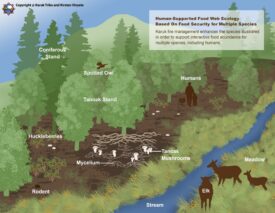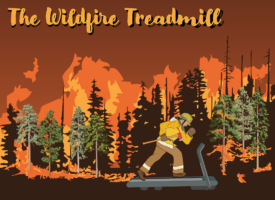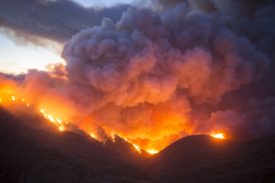Alan:
My contrarian nature had me—during Cascadia’s week of snow and ice—belatedly devouring Timothy Egan’s treatise on drought and fire. The Big Burn: Teddy Roosevelt and the Fire that Saved America (Houghton Mifflin Harcourt, 2009), like Egan’s others, is a masterfully told and deeply researched chronicle of people and nature. In this case, it’s about the state-sized firestorm of 1910 that engulfed Cascadia’s eastern forest province. The Bitteroots of northern Idaho and western Montana erupted in flame, consuming in hours many millions of board-feet of sun-dried timber, along with whole towns and scores of their residents. The subject matter is captivating, like many disaster stories, but what makes it worthy of Egan’s attention is not the disaster itself but the role the fire played in US history. Former President Teddy Roosevelt and his close friend and former Forest Service Chief Gifford Pinchot used the fire to rally the United States to the idea of conservation and, specifically, to the then-radical notion that the federal government in Washington, DC, was the guardian of the nation’s natural heritage. The political meaning of the fire—the way it cemented in US thought the progressive ideals of public stewardship and of natural resources as a universal birthright—justifies Egan’s subtitle about saving America. For me, it was also a story of exceptional relevance in today’s climate debates. Natural disasters and the political meanings we assign to them could save us, or destroy us, again.
Eric dP:
This week I came across the single best chart depicting income inequality that I’ve ever seen. It’s a chart that its creator economist Alan Krueger calls “The Great Gatsby Curve”—take a look at it here on Paul Krugman’s blog. Plotting income inequality against “generational earnings elasticity” (basically, the ability for younger generations to earn more or less than their parents), the chart shows that not only is the United States among the most unequal of wealthy nations, but it also provides among the worst opportunities for advancement. Even more astonishing, the US has gotten considerably worse on both measure since the 1980s, even relative to other countries. It baffles me that anyone can look at this chart and continue to argue that the American economy works for ordinary people.
I also took a little time during our big snow in Seattle to pick up Denis Johnson’s most recent book, Train Dreams. Johnson is one of my all-time favorite writers and it’s a special pleasure to read him writing about his neck of the woods in far north Idaho. For my money, Train Dreams ranks among the best books I’ve read about the Northwest. It’s short enough that you could blow through it in a couple of hours, I imagine. But it’s the kind of writing—careful, sincere, and eerie—that you should linger over in the quiet hours of a dark night.
Anna:
Glad to find Bill Moyers (a hero of mine) back in broadcast (radio this time). The premiere episode of “Moyers & Company” on my local NPR station featured the authors of a book I want to read too: Jacob Hacker and Paul Pierson’s fierce critique of winner–take–all politics, How Washington Made The Rich Richer — And Turned Its Back On The Middle Class. Moyers calls the duo “the Sherlock Holmes and Dr. Watson of political science.” If you read it, let me know what you thought (and send your used copy to Sightline—I’m not buying new books this year.)
Got snow? New research looks at how global warming can be spurring harsher winter storms in northern Europe, Canada, and right here in the Northwest.
And finally, this is not exactly a newsflash for Sightline readers, but it’s another solid piece of research affirming that walkable neighborhoods are good for us!
Residents of neighborhoods with a central core of shops and services – a pattern typically found in older, traditional communities – walk nearly three times more often than do residents of whose nearest shops lie along a major arterial road. This is true even when the data are controlled for individual and household economic and demographic characteristics. The study was led by Marlon Boarnet of the University of California at Irvine, assisted by several other researchers from southern California, Texas A&M, and UNC-Chapel Hill. It is published in the Fall 2011 issue of Access, the magazine of the University of California Transportation Center.
Clark:
From the gee-whiz files: Computerized “neural networks” can develop a sense of numbers without being programmed to count.
Also from New Scientist: globally, unsafe abortions rose when international family planning aid was cut. “Paradoxically…US restrictions on foreign aid may have promoted the abortions they sought to restrict.”
(Original article from the British medical journal The Lancet. Most interesting snippet from the summary: “The abortion rate was lower in subregions where more women live under liberal abortion laws (p<0·05).”)








Callie Jordan
Does “buying new books” also in/exclude Kindle Editions? All of the recommended reads are available in Kindle. Of course, it means buying from Amazon rather than the other local bookstore.
Actually, what I don’t like about Kindle isn’t so much Amazon as the fact the books can’t be reused, gifted or donated after I’m done. For that reason, I’m making an exception to my own “no new stuff” resolution.
Anna Fahey
Hi, Callie. I don’t think e-books count in my experiment. But I’m trying not to buy them either (even though I own a Kindle). You can get lots of books for your Kindle from the public library. (Occupy your wallet!)
AF
Mary
First, I’m reading Train Dreams and loving it. Thanks for the recommendation.
I work at an independent bookstore so you won’t find a Kindle anywhere near me. Ok, I’ve heard the arguments (save a tree–not necessarily true by the way; I just use it for travel; my kids gave it to me). So if you can’t resist an e-reader, go for something other than the kindle. Most other e-readers will allow you to go online to buy books through non-Amazon outlets, such as the bookstore you’d like to keep in your neighborhood.